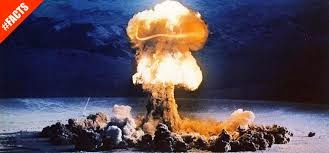
Atomic bomb, also called atom bomb, weapon with great explosive power that results from the sudden release of energy upon the splitting, or fission, of the nuclei of such heavy elements as plutonium or uranium.
On August 6, 1945, the United States dropped its first atomic bomb on the city of Hiroshima. The bomb was known as “Little Boy”, a uranium gun-type bomb that exploded with about thirteen kilotons of force. At the time of the bombing, Hiroshima was home to 280,000-290,000 civilians as well as 43,000 soldiers. Between 90,000 and 166,000 people are believed to have died from the bomb in the four-month period following the explosion.
Interesting Facts About Atomic Bomb
- Hiroshima and Nagasaki are not radioactive anymore mostly because the bombs didn’t touch the ground, but were detonated in the air.
- A Japanese man survived both the Hiroshima and Nagasaki atomic bombings during World War II.
- A survivor of Hiroshima’s atomic bombing went to Boston in 1951 and won the Marathon.
- FATMAN was the code name for the atomic bomb that was detonated over Nagasaki.
- Kokura, Japan, was the original target of the atomic bomb that landed in Nagasaki.
- A Bonsai Tree planted in 1626 survived the atomic bomb at Hiroshima and now resides in a U.S. Museum.
- A month after the nuclear bombing of Hiroshima, a typhoon hit the city killing another 2,000 people.
- 10% of US electricity is made from dismantled atomic bombs.
- In 1962, the U.S. blew up a hydrogen bomb in space that was 100 times more powerful than Hiroshima.
- The oleander is the official flower of the city of Hiroshima because it was the first thing to bloom again after the explosion of the atomic bomb in 1945.
- The first nuclear bomb was detonated on July 16, 1945, at Alamogordo, New Mexico. The second and third bombs fell on Hiroshima and Nagasaki in Japan on August 6 and August 9 respectively. They were products of the “Manhattan Project”.
- On Aug. 6, 1945, an atomic bomb was dropped on Hiroshima with an estimated equivalent explosive force of 12,500 tons of TNT, followed three days later by a second, more powerful, bomb on Nagasaki. Both bombs caused widespread death, injury, and destruction.
- Atomic bombs were subsequently developed by the USSR (1949; now Russia), Great Britain (1952), France (1960), and China (1964). A number of other nations, particularly India, Pakistan, Israel, and North Korea now have atomic bombs or the capability to produce them; South Africa formerly possessed a small arsenal.
- Among the atomic weapons are A-bomb, H-bomb, radioactive materials. First Atomic bomb was made at the end of the WW2.
- The first a-bomb was dropped on Hiroshima and Nagasaki. 2/3 of the city was destroyed.
Also, Read:

